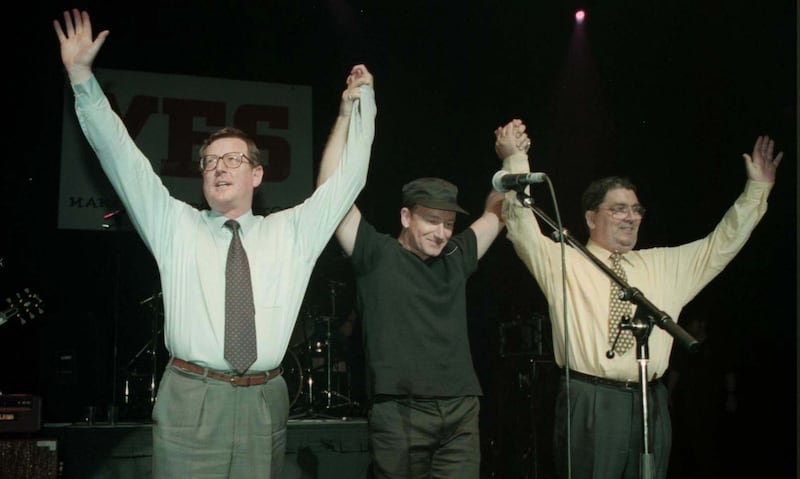Bertie Ahern gets a good press, cumulatively, in the State papers released this week. The Irish ambassador in London Daithí Ó Ceallaigh tells Dublin in November 2000 that Ulster Unionist Party leader David Trimble “set great store by his relationship with the Taoiseach”.
Ahern was affable, serious and knowledgeable; also a politician of prodigious energy, with a capacity to quickly master a brief and a reputation as a skilled negotiator. In the copious files in the Department of An Taoiseach, which are being made available for public viewing at the National Archives in January, there are annotations on individual files alerting Ahern to the important documents. Some others may have guidance as to whether “The Taoiseach knows all of this” and can be spared the chore of reading through it.
Such is the scale of working papers in the multiparty talks which followed the Belfast Agreement that it must have been the case that many of those representing their parties in the talks found themselves “winging it” for part of the time.
It was undoubtedly the case that the Irish government had by far the most sophisticated and the most knowledgeable experts involved in these talks.
RM Block
They were an intelligence-gathering secretariat, deeply experienced over many decades dealing with just this agenda. Trimble, in the salute to Ahern already quoted, added that “the measured and solid approach” of Brian Cowen, as minister for foreign affairs, was “recognised”.
Blair for his part described Ahern as “one of my favourite political leaders” who became a true friend: “He was heroic throughout the whole process, smart, cunning in the best sense, strong, and, above all, free of the shackles of history”.
Ahern had long experience of watching how the Northern Ireland issue could destabilise Fianna Fáil. In 1972 in the aftermath of Bloody Sunday, the Lynch government had failed to protect the British embassy in Dublin from being burned down; in 1976 the incoming British ambassador had been assassinated; and in 1981 the impact of H-Block candidates arguably cost Fianna Fáil victory in Haughey’s first election as party leader.
Ahern had promised nothing less than a recasting of the Irish-British relationship, stating that Lloyd George “had failed to resolve the conflict of political allegiances within Ireland” and promising to replace the 1920-1921 settlement with something deeper which would “achieve the basis of a just and durable solution”.
Ahern was also fortunate that he came to power at a time when Blair had won a landslide victory in 1997 for Labour at Westminster. Both men remained as leaders for the decade which followed.
Both men were in their mid-40s. And they had another energetic and ambitious friend in the White House, another innovative politician who had achieved his ambition at much the same age: Bill Clinton.
Moreover, Blair and Clinton were both covetous of a foreign-policy success. And for Ahern, there was also a coveted if controversial prize. Admittedly it involved embracing the heresy of abandoning the irredentist claim on “the lost Six Counties”; but it also gave him the opportunity of replacing that with a roadmap towards Irish unity which he believed could be sold to the Fianna Fáil faithful and to the wider electorate.
Admittedly difficult of attainment, was this not a historic prize? Was it not a more constructive way forward than the old package with which so many of his predecessors had to be content: the grievance of partition combined with an indefinitely postponable aspiration to unity?

Ahern stamped his own mark on the peace process. Emphatically he was not a believer in unilateral announcement of deadlines. He believed them to be invariably unhelpful.
Rather his opinion had “long been, and remains” that such an approach was negative; and that it would prove more constructive to work on the assumption that positive benefits – “peace, working constructively together and true justice” – would follow if one simply prioritised the implementation of the agreement.
This modus operandi would be recognisable to Jonathan Powell – Blair’s chief of staff – and others who often likened the peace process to riding a bicycle. Keep cycling and it’s on course: stop and it’s at risk of toppling over.
Blair often struck a similar note: at Hillsborough on July 4th, 2002, he told the parties that the agreement “involved a transition to legitimate politics and it was vital that the transition be seen to be progressive and irreversible”.
Typical of the intelligence-gathering approach of the Dublin mandarins was the logging of the Irish ambassador in London’s account of a private lunch in Salisbury hosted by the former British prime minister Edward Heath. Ó Ceallaigh reported that Heath had aged a lot but remained “very sharp intellectually if somewhat feeble physically”.
He had full-time police protection which he felt he needed because of Bloody Sunday. “He does not, he said, feel safe.”
Heath is reported as believing that “current progress” in Northern Ireland “rests on the principles which had been negotiated at Sunningdale”. And he further claimed that but for “the weakness” of the incoming Harold Wilson government in 1974, “Sunningdale would have worked”.
Ó Ceallaigh concluded his report with a formal comment: “Heath, naturally, is anxious to ensure his role, and its importance, endures.”
What the ambassador found extraordinary was that there was “no understanding at all of the enormity of what happened in Derry when British soldiers shot dead 13 unarmed civilians in a country supposedly governed by the rule of law”.
Heath’s cursory and self-serving account of Bloody Sunday in his memoirs does little to offset this Ó Ceallaigh verdict. Nor is there anything other than complacent acceptance of the discredited Widgery whitewash – although he does note to Ó Ceallaigh the setting up of the Saville inquiry to review Widgery.
Blair, for his part, who initiated Saville as a confidence-building measure at the start of the peace process, eventually decided that although it had lasted some 12 years and had cost almost £200 million, it had been justified: “an exhaustive and fair account of what happened”.
But why had it been necessary to spend such a sum to reach a verdict which poet Thomas Kinsella had established within a week of the Widgery whitewash and at a cost of a mere four pence? This was the cover price of the Peppercannister printing of Kinsella’s masterly polemic: Butcher’s Dozen.
“Does it need recourse to law/To tell ten thousand what they saw?”
Meanwhile, Blair is left with ownership of what must be the greatest “howler” of the Troubles. In his official memoir he writes that to assuage nationalist opinion he had ordered an inquiry into Bloody Sunday when British troops had “opened fire on protesters in Belfast [sic], killing a number of people”.
The British Labour Party was also being invited to embrace heresies. How many factions did they now contain on the question which had challenged the party throughout its history: the partition of Ireland?
The Belfast Agreement had changed this debate. The controversial unionist veto on Irish unity had been replaced by a quite other formulation: the need to win the support of a majority within Northern Ireland before any such reunification could happen.
The unionist brakes on Irish unity were still there but the mechanism to exercise the brakes had altered: whereas a majority vote in the old Stormont parliament would have precluded Irish unity up to 1972, this was now to be subjected to a popular vote in the entire province and nationalists and unionists would be free to campaign for what they preferred.

Trimble’s supporters claim that it was his achievement that he recognised the erosion of bipartisan support at Westminster for the union, and appreciated that so much of its strongest expressions in recent decades had been triggered by the self-interest of British governments momentarily dependent on unionist votes in the Commons.
Times had changed and the Belfast Agreement – challenging as it was to unionists – was the least worst option. It was also that to Ahern and to the other stakeholders who signed off on it at Easter 1998. That it would then be endorsed by 85 per cent of all the voters throughout Ireland in the joint referendum some weeks later was a historic milestone.
That the continuing bickering ever since has eroded that support cannot be gainsaid. But also historic was the fact that a majority of voters in Northern Ireland did vote against Brexit. That should count for something. And for how long can the DUP ignore those voters who are supportive of a renewal of devolved powersharing at Stormont?
* Dr John Bowman is a broadcaster and historian. His De Valera and the Ulster Question: 1917-1973 won the Ewart Biggs Prize for its contribution to North-South understanding. He has written for more than 40 years on the release of State papers for The Irish Times














